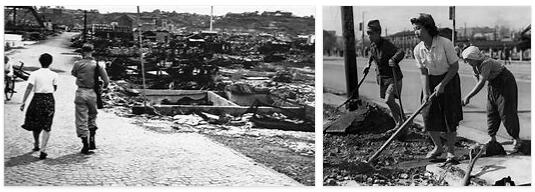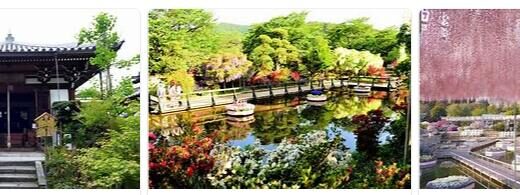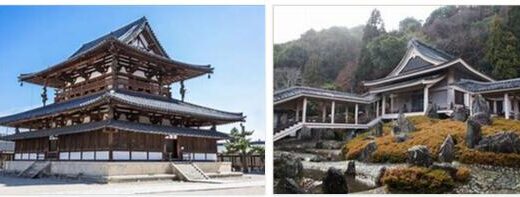Japan After World War II
Employment regime. – In accordance with the quadripartite declaration of Potsdam, the conditions of surrender and the plan of the American government of 6 September, the gen. Douglas Mac Arthur, proceeded with his troops to the complete occupation of all the Japanese islands.
The first measures of the American command were: the recognition of a new Japanese government headed by Prince Naruhiko Higashi Kumi, a joint of the emperor, who seemed to offer greater guarantees for the regular completion of operations; consent to freedom of the press; the total demilitarization of Japan through the abolition of the general staff, conscription, military education and all relevant laws and institutions; the granting of a large amnesty; the release of prisoners of war; the beginning of the trial (later closed, with many sentences, including capital, in November 1948) against a few hundred political and military leaders brought to trial before the Tōkyō International Tribunal as war criminals. Among the accused were General Hideki Tōjō,
Among the immediate provisions of a humanitarian nature, there are the relief of basic necessities, which the allied command has continued to provide to populations in need, and the special assistance provided on the occasion of the earthquake of 31 December 1946 in Shikakua, which caused serious destruction. in an area of 60,000 square miles, with thousands of dead, injured and homeless.
In December, the Moscow Conference appointed an Eastern Commission for Japan, based in Washington, composed of all the representatives of the allied powers, with the task of supervising compliance with the surrender clauses. As an executive body, a military and civilian control committee was established in Tōkyō, which began to take various measures in all orders of Japanese life: in the statutory, economic-financial, social and cultural, in order to eliminate any formal trace of feudalism., of caste privileges and military and bureaucratic oligarchy, promoting in the country a profound renewal in all its structure to later insert it into the peaceful consortium of free nations.
Constitution. – The new constitution, which replaces that of 1899, was approved on August 24, 1946 by the House of Representatives and then, on October 7, by that of councilors, and thus came into force on May 7, 1947. The constitution is inspired by to the Anglo-Saxon and French systems, and formally transforms Japan into a parliamentary representative democracy.
Composed of 95 articles, it contains a preamble with a declaration of principles, including: the proclamation of the sovereignty of the people, with the cessation of the divine prerogatives of the emperor, who remains simply a symbol of the state and its unity; the solemn renunciation of war; the affirmation of the inviolable freedoms of man and citizen: of speech, of the press, of association, of religion; the equality of all cults before the law, etc. Sovereignty is exercised by the three powers: the legislative is established with the bicameral system, constituted by the Diet or parliament, i.e. the House of Representatives in number of 466, elected by universal suffrage also extended to women, and the Chamber of Councilors, which replaced the House of Peers. The executive power is accountable to the Diet.
According to CLOTHESBLISS, the first general elections took place in the spring of 1946, and in them five main parties emerged: democratic, progressive, socialist, communist and liberal, which had the majority of votes. The second political elections took place on April 25, 1947: in them the socialists led by Prime Minister Tetsu Katayama prevailed.
In harmony with the radical constitutional reform, the decentralization of the government and the democratization of local autonomous bodies was also provided. Nor has there been a lack of revision of the civil and penal codes and other fundamental laws according to the most democratic principles.
Economic and social policy. – The allied command was inspired in its action by the directives established by art. 11 of the Potsdam Declaration and part 4 a of the occupation program, on the basis of which his work intended to promote and ensure:
a) the transformation of all the Japanese war industries and of any other form of activity aimed at feeding military forces, into those of peace, with the reduction of the merchant navy in correspondence only to the needs of commercial traffic;
b) the restoration of a healthy economy and the radical reform of all economic institutions with the immediate aim of maximizing the production of the most urgent goods, that is, food, clothing, housing, etc.;
c) the restitution to the legitimate owners of all the assets stolen from them during the war operations;
d) the supply of products and services needed by the occupation forces, as well as the payment of reparations avoiding, as far as possible, compromising the economic recovery of the country and the maintenance of a minimum standard of civilian life for the Japanese people;
e) the prohibition of all foreign trade, unless authorized by the allied command;
f) the reorganization of all economic, financial and social activities, through the abolition of monopolies (Zaibatsu) with the law of July 1947; the elimination of all previous controls on industry and trade, the introduction of important reforms in the agricultural, banking, fiscal sector, especially in the organization and protection of labor in order to guarantee a more equitable distribution of capital and income.
The worsening of the tension between Moscow and Washington, combined with the progressive weakening of positions in China, seem to induce the United States to reconsider much of its primitive program of action in Tōkyō to accelerate the reconstruction of Japan on a broader basis and assign it an increasingly important political, economic and military role.
Social policy. – The law of 21 December 1945 on workers’ unions, also promoted by the employment government, recognizes for the first time in Japan the main rights of work, organization, strike, etc. As of November 30, 1947, the workers’ unions of each category had already reached the number of 26,420 with 5,993,613 members and had formed a national federation closely linked to the Social Democratic party, which began to hold congresses, to decide strikes to increase wages., for factory control and other claims. Social reforms include the law of October 1946 on assistance to the destitute and that of April 1947 for insurance against accidents at work, taking an example from the most advanced modern systems.
Education. – Also in this sector, the Allied government has promoted from the beginning important reforms of the programs and of the institutions in order to make all marks of nationalism and totalitarianism disappear. The directives of the new system are contained in the law of 25 March 1947. In May of the same year the elementary and secondary schools reopened to 49,596 with 558,640 teachers and 17,682,938 pupils.



